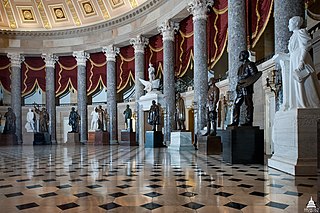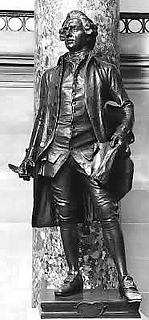
John Hanson was a Founding Father of the United States, and a merchant and public official from Maryland during the era of the American Revolution. In 1779, Hanson was elected as a delegate to the Continental Congress after serving in a variety of roles for the Patriot cause in Maryland. He signed the Articles of Confederation in 1781 after Maryland joined the other states in ratifying them. In November 1781, he was elected as first President of the Confederation Congress, following ratification of the articles. For this reason, some of Hanson's biographers have argued that he was actually the first holder of the office of President of the United States.

The National Statuary Hall is a chamber in the United States Capitol devoted to sculptures of prominent Americans. The hall, also known as the Old Hall of the House, is a large, two-story, semicircular room with a second story gallery along the curved perimeter. It is located immediately south of the Rotunda. The meeting place of the U.S. House of Representatives for nearly 50 years (1807–1857), after a few years of disuse in 1864 it was repurposed as a statuary hall; this is when the National Statuary Hall Collection was established. By 1933 the collection had outgrown this single room, and a number of statues are placed elsewhere within the Capitol.

The National Statuary Hall Collection in the United States Capitol is composed of statues donated by individual states to honor persons notable in their history. Limited to two statues per state, the collection was originally set up in the old Hall of the House of Representatives, which was then renamed National Statuary Hall. The expanding collection has since been spread throughout the Capitol and its Visitor's Center.

Charles Henry Niehaus, was an American sculptor.

Richard Edwin Brooks (1865–1919) was born in Braintree, Massachusetts, studied in Paris under the sculptor Jean-Paul Aubé (1837–1916). His early work Chant de la Vague was idealistic; later works were more conventional statues.
Anne Whitney created two public statues of Samuel Adams. One, made in 1876, resides in the National Statuary Hall Collection in the US Capitol, Washington, D.C.. The other, made in 1880, is located in front of Faneuil Hall Plaza in Boston.

Will Rogers is a statue created by Jo Davidson, two versions of which were unveiled in 1938.
Barry Goldwater is a bronze sculpture depicting American politician and businessman of the same name by Deborah Copenhaver Fellows, installed at the United States Capitol's National Statuary Hall, in Washington, D.C., as part of the National Statuary Hall Collection. The statue was donated by the U.S. state of Arizona in 2015, and replaced a statue of John Campbell Greenway, which the state of Arizona gifted to the collection in 1930.

Jefferson Davis, created by Henry Augustus Lukeman, is a bronze sculpture of Jefferson Davis – a U.S. Senator, U.S. Secretary of War, plantation owner and the only President of the Confederate States of America – commissioned by the U.S. State of Mississippi for inclusion in National Statuary Hall Collection at the United States Capitol's National Statuary Hall, in Washington, D.C.. The statue was controversial at the time of its unveiling and there have been efforts to remove it from the Capitol from 2015 onward.

Henry Mower Rice is a marble sculpture of Henry Mower Rice created by Frederick Triebel and placed in the National Statuary Hall Collection in the Capitol Building in Washington, D.C., one of the two statues there from the State of Minnesota. It was dedicated in 1916. The work cost $7,500 and was unveiled in Washington on February 8, 1916.

Charles Carroll is a bronze sculpture depicting Charles Carroll of Carrollton by Richard E. Brooks, installed in the United States Capitol's crypt, in Washington, D.C., as part of the National Statuary Hall Collection. The statue was gifted by the U.S. state of Maryland in 1903.

Brigham Young is a marble statue by Mahonri Young representing the Mormon religious leader of the same name, installed in the United States Capitol, in Washington D.C., as part of the National Statuary Hall Collection. It is one of two statues donated by the state of Utah, and is unusual in the collection in that Young is portrayed sitting down. The statue was unveiled by Alben William Barkley on June 1, 1950.

John M. Clayton is a 1934 marble sculpture depicting the American lawyer and politician of the same name by Bryant Baker, installed in the United States Capitol, in Washington D.C., as part of the National Statuary Hall Collection. It is one of two statues donated by the state of Delaware The statue was accepted in the collection by Robert G. Houston on June 6, 1934.
Huey Long is a 1941 bronze sculpture of Huey Long by Charles Keck, installed in the United States Capitol, in Washington, D.C., as part of the National Statuary Hall Collection. It is one of two statues donated by the state of Louisiana.

Crawford Long is a 1926 marble sculpture depicting the American surgeon and pharmacist of the same name by J. Massey Rhind, installed in the United States Capitol, in Washington, D.C., as part of the National Statuary Hall Collection. It is one of two statues donated by the U.S. state of Georgia.

Peter Muhlenberg, or John Peter Gabriel Muhlenberg, is an 1889 marble sculpture depicting the American clergyman, soldier, and politician of the same name by Blanche Nevin, installed in the United States Capitol's crypt, in Washington, D.C., as part of the National Statuary Hall Collection. It is one of two statues donated by the state of Pennsylvania. The statue was accepted into the collection on February 28, 1889 by Pennsylvania Congressman Daniel Ermentrout.
Francis Harrison Pierpont is a 1910 marble sculpture of Francis Harrison Pierpont by Franklin Simmons installed in the United States Capitol, in Washington, D.C., as part of the National Statuary Hall Collection. It is one of two statues donated by the state of West Virginia. The sculpture was unveiled by the Hon. Thomas Condit Miller, on April 27, 1937.

Roger Williams is an 1872 marble sculpture of Roger Williams by Franklin Simmons, installed in the United States Capitol, in Washington, D.C., as part of the National Statuary Hall Collection. It is one of two statues donated by the state of Rhode Island. The sculpture was unveiled by Senator William Sprague of Rhode Island on January 9, 1872.
James Shields is an 1893 bronze sculpture of James Shields by Leonard Volk, installed in the United States Capitol, in Washington, D.C., as part of the National Statuary Hall Collection. It is one of two statues donated by the state of Illinois. The sculpture was unveiled by Senator Shelby Moore Cullom of Illinois on December 6, 1893.

John Campbell Greenway is a 1930 bronze statue of John Campbell Greenway by Gutzon Borglum, one version of which was installed in the United States Capitol, in Washington D.C., as part of the National Statuary Hall Collection. It was one of two statues donated by the state of Arizona. The sculpture was unveiled by Senator Henry Ashurst of Arizona on May 24, 1930.















